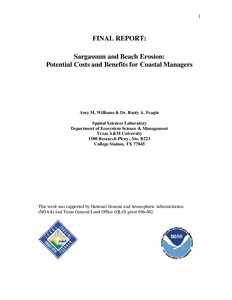Sargassum and Beach Erosion: Potential Costs and Benefits for Coastal Managers: final report.

View/
Average rating
votes
Date
2010Author
Williams, Amy
Feagin, Rusty A.
Status
PublishedPages
47pp.
Metadata
Show full item recordAbstract
Sargassum fluitans and natans, types of brown algae wash up on Galveston Island, Texas each year from May to August. Sargassum smells bad, hurts tourism and impairs sea turtle hatchings. Coastal managers are confronted with the difficult choice of cleaning Sargassum off the beach front or leaving it alone. The current beach management practice is to rake the algae with mechanical tractors and deposit it at the base of the dunes. The environmental impacts of raking and ecological benefits of Sargassum are unknown. The Galveston Island Park Board of Trustees (GIPBT) used to rake all beaches under their management before Hurricane Alicia in 1983. Then, citizens started to complain that raking was causing erosion. Now, there are people who argue for raking and leaving the beach alone. Environmental policies require complex decisions that take into consideration social, economical, ecological, and cultural values. The GIPBT initiated the Sargassum Policy Committee to gain knowledge of diffe.....
Publisher
Texas A & M University, Department of Ecosystem Science & ManagementCollege Station,TX
Document Language
enSustainable Development Goals (SDG)
14.2Essential Ocean Variables (EOV)
Macroalgal canopy cover and compositionBest Practice Type
Standard Operating ProcedureCitation
Williams, A.M. & Feagin, R.A. [2010] Sargassum and Beach Erosion: Potential Costs and Benefits for Coastal Managers: final report. College Station, TX, Texas A&M University, Department of Ecosystem Science & Management, 47pp.DOI: http://dx.doi.org/10.25607/OBP-998Collections
 Repository of community practices in Ocean Research, Applications and Data/Information Management
Repository of community practices in Ocean Research, Applications and Data/Information Management